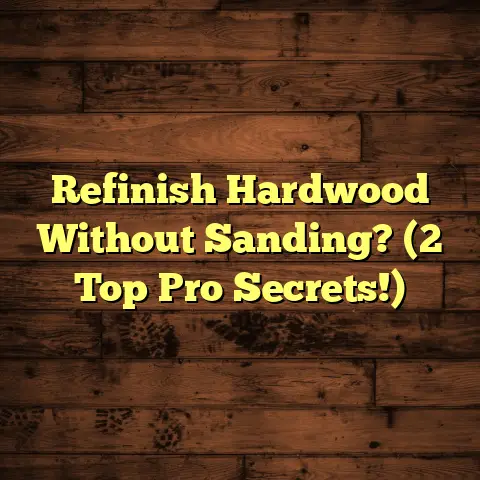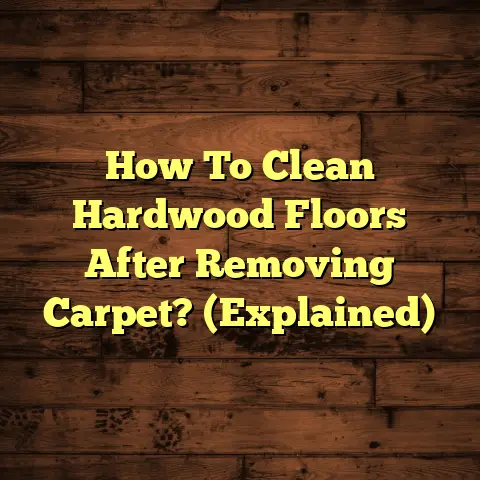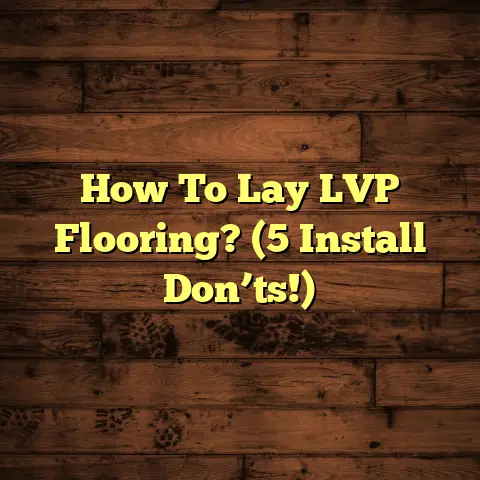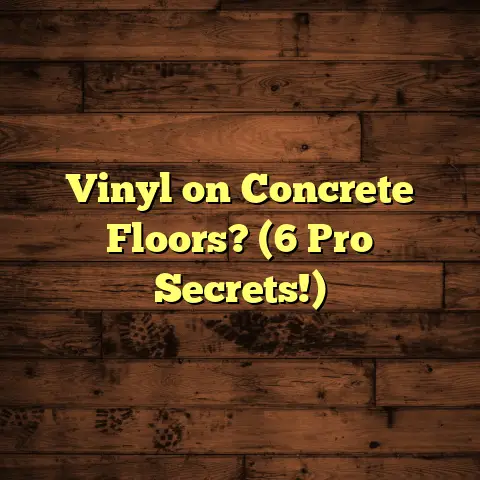Does Swiffer Ruin Laminate? (3 Floor Fails!)
I get it.
Laminate is fantastic – it’s affordable, looks great, and
seems easy to keep clean.
But is that Swiffer really the best tool
for the job?
That’s the question I want to tackle today.
As a flooring contractor
with years of experience, I’ve seen firsthand what can happen when
good intentions meet the wrong cleaning methods.
We’re going to dive deep into the world of laminate, Swiffers, and, unfortunately, “floor fails.” I’ll walk you through three common problems I’ve seen time and time again, all potentially linked to Swiffer use.
So, grab a cup of coffee, and let’s get started!
Understanding Laminate Flooring
Let’s start with the basics: What is laminate flooring, anyway?
It’s not solid wood, that’s for sure.
Instead, it’s a multi-layered
synthetic product designed to mimic the look of wood, tile, or even
stone.
Think of it like a high-tech sandwich.
Here’s the breakdown:
Wear Layer: This is the top layer, the one you walk on.
It’s a clear, protective coating designed to resist scratches, stains, and fading.Design Layer: This is where the magic happens!
A high-resolution photographic image gives the laminate its realistic appearance.-
Core Layer: Usually made of high-density fiberboard (HDF) or medium-density fiberboard (MDF), this layer provides the floor with its stability and resistance to impact.
-
Backing Layer: The bottom layer helps to protect the core from moisture and provides a stable base.
Durability and Maintenance
Laminate is known for being pretty tough.
It can handle everyday wear
and tear, kids, pets, and even the occasional dropped plate (we’ve all
been there!).
But, like any flooring, it needs proper care to last.
The key is to
protect that wear layer and prevent moisture from seeping into the core.
Here are a few general maintenance tips:
-
Sweep or vacuum regularly: Get rid of dirt and debris that can scratch the surface.
-
Use a damp mop: Avoid soaking the floor with water.
-
Clean up spills immediately: Don’t let liquids sit on the surface.
-
Use floor protectors under furniture: Prevent scratches from moving chairs and tables.
Swiffer’s Appeal
Now, let’s talk about Swiffers. Why are they so popular? Because they’re incredibly convenient!
They’re lightweight, easy to maneuver, and the disposable pads make
cleaning a breeze.
Plus, the commercials promise sparkling clean floors
with minimal effort.
Who wouldn’t want that?
For many, Swiffers seem like the perfect solution for quick cleanups
and maintaining a tidy home.
But the question remains: are they too
good to be true when it comes to laminate?
The Science Behind Swiffer Products
Okay, let’s put on our lab coats and examine what’s actually in those Swiffer products and how they might interact with laminate.
Overview of Swiffer Products
Swiffer offers a range of cleaning tools, but the most common ones for floors are:
-
Swiffer WetJet: This sprays a cleaning solution onto the floor while you mop.
-
Swiffer Sweeper: This uses dry cloths to pick up dust, dirt, and hair.
-
Swiffer Wet Cloths: Pre-moistened cloths that attach to the Swiffer Sweeper for damp mopping.
Cleaning Agents
The cleaning solutions used in Swiffer products are proprietary, meaning
the exact formulas are kept secret.
However, we can make some educated
guesses based on safety data sheets and product descriptions.
Typical ingredients include:
-
Water: The main solvent.
-
Cleaning agents: Surfactants that help to lift dirt and grime.
-
Solvents: Help to dissolve grease and oils.
-
Preservatives: Prevent the growth of bacteria and mold.
-
Fragrances: Give the product its scent.
Some of these ingredients, especially the solvents and fragrances, can be harsh on certain surfaces.
Impact on Flooring
So, how can these ingredients and the Swiffer pads themselves affect
laminate flooring over time?
Here’s what I’ve observed and learned:
Moisture: Laminate is susceptible to water damage.
Excessive moisture can seep into the seams and cause the core to swell, leading to warping and buckling.-
Cleaning Solutions: Some cleaning agents can strip the protective wear layer, leading to a dull finish and discoloration.
-
Physical Abrasiveness: The Swiffer pads, especially the thicker ones, can be abrasive and cause micro-scratches on the surface.
Now, let’s get into those “floor fails” I mentioned earlier.
Floor Fail #1 – Warping and Buckling
This is probably the most common issue I see related to improper
laminate cleaning.
Warping and buckling occur when the core layer of
the laminate absorbs too much moisture.
Imagine a sponge.
When it’s dry, it’s firm and flat.
But when you soak
it with water, it expands and becomes misshapen.
The same thing happens
to laminate flooring.
Description of the Issue
Excessive moisture from Swiffer WetJet or even overly damp Swiffer Wet
Cloths can seep into the seams between the planks.
The core layer,
usually made of HDF or MDF, acts like that sponge and soaks it up.
As the core swells, the planks start to push against each other.
This
creates pressure, which can lead to:
- Warping: The planks start to curve or bend upwards.
- Buckling: The planks lift up from the subfloor, creating a raised area.
Case Studies or Anecdotes
I remember one client, Sarah, who was meticulous about cleaning her
laminate floors.
She used her Swiffer WetJet every other day, thinking
she was doing a great job.
“I loved how easy it was,” she told me.
“Just spray and wipe, and my
floors looked so clean!”
But after a few months, she started noticing that the planks in her
kitchen were starting to lift up.
At first, it was just a small area
near the dishwasher.
But over time, the buckling spread to other parts
of the kitchen.
When I inspected her floors, it was clear that excessive moisture was
the culprit.
The core layer of the laminate was swollen and crumbling.
Sarah was devastated.
She had to replace her entire kitchen floor, a
costly and time-consuming project.
Visual Evidence
Here’s what warping and buckling can look like:
(Imagine a photo here showing laminate flooring with warped and buckled planks)
Notice how the planks are no longer flat and even?
That’s a clear sign
of moisture damage.
Floor Fail #2 – Dullness and Discoloration
Even if you don’t experience warping or buckling, using the wrong
cleaning products can still damage your laminate floors.
Dullness and
discoloration are common issues I see, often linked to harsh cleaning
agents.
Description of the Issue
The wear layer of laminate flooring is designed to protect the design
layer underneath.
But it’s not indestructible.
Certain chemicals can strip away the protective coating, leaving the
floor looking dull and lifeless.
Over time, this can also lead to
discoloration, especially in high-traffic areas.
Chemical Reactions
The cleaning solutions in some Swiffer products contain solvents and
other chemicals that can react with the wear layer of laminate.
These
chemicals can break down the protective coating, making it more
susceptible to scratches and stains.
Homeowner Experiences
Another client, Mark, contacted me because his laminate floors were
starting to look faded and worn.
He had been using a Swiffer WetJet
with the original cleaning solution for years.
“I thought I was taking good care of my floors,” he said.
“But they just
don’t look as good as they used to.”
When I examined his floors, I noticed a hazy film on the surface.
This
was likely caused by the cleaning solution reacting with the wear layer.
I recommended that Mark switch to a pH-neutral cleaner specifically
designed for laminate floors.
He also had to invest in a floor
restorer to bring back some of the shine.
Floor Fail #3 – Surface Scratches and Damage
Finally, let’s talk about scratches.
Even if you’re careful, everyday
life can take a toll on your floors.
But using abrasive cleaning pads
can make the problem even worse.
Description of the Issue
The Swiffer pads, especially the thicker ones designed for scrubbing,
can be abrasive.
When you use them to clean your floors, they can create
micro-scratches on the surface.
These scratches may not be visible at first.
But over time, they can
accumulate and make your floors look dull and worn.
Impact on Longevity
Scratches not only affect the appearance of your floors, but they can
also shorten their lifespan.
Scratches can weaken the wear layer, making
it more susceptible to damage from moisture and stains.
Expert Opinions
I’ve talked to several flooring manufacturers about the use of Swiffers
on laminate.
The general consensus is that while Swiffers can be used
occasionally for quick cleanups, they shouldn’t be the primary cleaning
method.
“We recommend using a microfiber mop and a pH-neutral cleaner specifically
designed for laminate floors,” one manufacturer told me.
“This will
help to protect the wear layer and prolong the life of your floors.”
Conclusion
So, does Swiffer ruin laminate? The answer, unfortunately, is it can.
While Swiffers are convenient and easy to use, they also pose some
risks to your laminate floors.
Excessive moisture, harsh cleaning
agents, and abrasive pads can all cause damage over time.
I’ve shown you three common “floor fails” I’ve witnessed:
-
Warping and Buckling: Caused by excessive moisture seeping into the core.
-
Dullness and Discoloration: Caused by harsh chemicals stripping the wear layer.
-
Surface Scratches and Damage: Caused by abrasive cleaning pads.
The key takeaway here is to be mindful of your cleaning choices.
Understand
the potential risks and take steps to protect your flooring investment.
Call to Action
I’d love to hear your experiences with Swiffers and laminate floors.
Have
you had any problems?
What cleaning methods do you prefer?
Share your thoughts in the comments below!
Let’s create a community
discussion around laminate floor care and cleaning methods.





